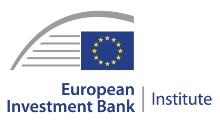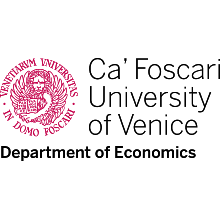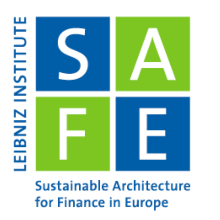ESG-Credit.eu
ESG Factors and Climate Change for Credit Analysis and Rating
EIBURS project financed by the European Investment Bank Institute
The Project
The aim of the ESG-Credit.eu project is to implement a methodology to include environmental, social and governance (ESG) criteria in credit analysis and ratings, including specifically the impact of climate change. Given that ESG factors measure the firm’s sustainability and its ethical skills, the project investigates how those factors affect the creditworthiness of a firm measured by credit ratings over time. Moreover, the project includes in the analysis the impact that climate change could exert over a firm belonging to a certain industry and proposes a possible way to include ESG factors and climate change scenarios in credit risk analysis.

The Consortium
Department of Economics - Ca’ Foscari University of Venice
Ca’ Foscari University of Venice is a public University with a national and international outstanding reputation for academic excellence in both teaching and research. The Department of Economics develops knowledge and understanding of economic phenomena dealing with the complexity of global market scenarios and exploring related social, juridical, ethical and environmental implications.
A new research Center in Economic and Risk Analytics for Public Policies (VERA Center) has been created and it focuses on big data applied to social welfare and wellbeing, risk analytics and evaluation of public policies. The Department is involved in several European projects in the field of sustainable finance, Energy Efficiency and ESG criteria: EIBURS-ESG-Credit.eu, EeMMIP- Energy efficient Mortgage Market Implementation Plan; EeDaPP - Energy efficiency Data Protocol and Portal; EeMAP - Energy efficiency Mortgages Action Plan.
Leibniz Institute SAFE
The Leibniz Institute SAFE is a research institute dedicated to research and research-based policy advice in all areas of finance, with a special focus on Europe. Its research program includes six research areas: Financial Intermediation, Financial Markets, Household Finance, Money & Finance, Macro & Finance, and Law & Finance. With its international and interdisciplinary group of researchers, SAFE combines the methodological and professional competences for a broad range of topics related to financial markets and financial institutions.
This also includes topics of sustainable finance, climate change and energy efficiency mortgages. A unique feature of SAFE is its Data Center, which provides data access to all the major financial and economic data providers (FactSet, Datastream, Bloomberg and CRSP/Compustat) and creates new European datasets. The SAFE Policy Center distributes and disseminates research findings to the policymakers and regulators. The main goal is to provide theory- and evidence-based policy advice on fundamental political challenges.
Department of Economics, Management and Statistics - University of Milano Bicocca
The Department of Economics, Management and Statistics (DEMS) of the University of Milano-Bicocca is one of Italy's leading economics departments, as certified by its excellent results in the quality of research assessment exercises (VQR) periodically carried out by the Italian National Agency for the Evaluation of Universities, and is committed to excellence in both teaching and research.
The DEMS is part of the School of Economics and Statistics of the University of Milano-Bicocca.
The DEMS was founded in 2012 by merging the Department of Economics with groups of scholars of statistical and business disciplines from other departments of the same university.
The academic staff of the DEMS is grouped in the following sections: Economics, Management (ISTEI) and Statistics.
Main Results
The ESG-Credit.eu project was designed to help in implementing a methodology to include ESG criteria and climate change factors in credit analysis and ratings. Given that ESG factors measure the firm’s sustainability and its ethical skills, the project was meant to investigate how these factors affect the creditworthiness of a firm over time.
During the last three years, the economic outlook of Europe has changed significantly. The pandemic and the more recent Ukrainian crises have shifted the priorities of the European agenda toward more concerning and urgent issues. Yet, we believe that the results and the analysis of this project will help regulators and policymakers in better understanding ESG ratings and factors, and their implications on credit risk. The project is centred mainly on European economies, delivered 10 different studies, and involved different research groups from three institutions.
The project started with a broad literature review covering several aspects related to environmental, social, and governance (ESG) factors. Specifically, studies describing and evaluating ESG methodologies and those studying the impact of ESG on credit risk, debt and equity costs, or sovereign bonds have been studied. Moreover, expanding the topic of ESG research by including the strand of the literature focusing on the impact of climate change on financial stability, the final deliverable considers also the most recent research on the impact of climate change on portfolio management.
As the initial research proposal involved the development of an augmented credit rating that takes into consideration the ESG rating of firms, an important step was first to deeply understand and study the market of ESG ratings. The team analyzed the ESG rating criteria used by prominent agencies and show that there is a lack of commonality in the definition of ESG (i) characteristics, (ii) attributes and (iii) standards in characterising E, S and G components. Aside from that, the heterogeneity in rating criteria can lead agencies to have opposite opinions on the same evaluated companies and that agreement across those providers is substantially low.
The result of this analysis urged the research groups to shift their attention from ESG ratings toward more granular ESG metrics. The development of WP1 helped in this direction. The final database used for this project includes about 650 ESG key performance indicators (KPIs) for European and UK companies when available. These granular data have been mostly collected from Bloomberg and Refinitiv. Moreover, the database has been complemented with data provided by MSCI and NRG metrics. In this way, each research group could select a subset of the database for their analysis.
This first part of the analysis represented a radical shift from the initial research plan and gave the researchers not only the opportunity to extend the research goals of the project but also to develop a more holistic approach. For instance, instead of studying the effect of ESG ratings on credit risk, the team formalized models to capture the effect of single ESG factors on credit risk.
Finally, the project team included in the analysis the impact that climate change could exert over a firm belonging to a certain industry and proposes a possible way to include ESG factors and climate change scenarios in credit risk analysis.
Literature Review
The project started with a in depth analysis of the literature by highlighting the different approaches and databases used in the literature and the main drawbacks. We found that a very large majority of studies conclude that positive ESG ratings are associated with an improvement in credit ratings, a reduction in CDS spreads, and a decrease in costs of equity capital and debt. However, we argue that divergence of ESG ratings makes these results uncertain. An important remark for practitioners and academics alike when making analysis on ESG ratings and credit risk is to perform robustness test to check if the results hold when using ESG ratings provided by different raters.
Publications
Billio M., Costola M., Hristova I., Latino C., Pelizzon L., 2022, Sustainable Finance: A Journey Toward ESG and Climate Risk, SAFE Working Paper No. 349
Data and Database structure
We have identified 14,626 companies, which are distributed in all the 27 EU countries and in the United Kingdom. A relevant aspect to highlight is that the list of companies also includes firms that have stopped their activities or have been delisted since 2000. This is a key aspect in the analysis since it avoids of incurring in any survivorship bias. We implemented a static map, which expresses static information for each company in the universe. Specifically, for each firm we have information about its identification (ISIN, RIC, CUSIP, …), description (Name, Country of Headquarter, Market in which the company is listed, …), and classification, both at an industry and at a sector level (GICS, TRBC, NACE). After the identification of the universe of firms where to rely on in the construction of the database, the following, natural step consisted in the development of a comprehensive set of metrics, wide enough to ensure the performance of complete and correct analysis. With the aim of finding an appropriate set of measures, different data providers were explored, namely: Thomson Reuters Eikon, Bloomberg, MSCI and CDP. We use also other providers, such as NRG and Standard Ethics.
The overall list of metrics counts 1125 variables. Due to this large volume of indicators, they were divided in groups, depending on the topic they are referred on. The distribution was developed identifying the following four categories:
- Market Data. It is the lowest populated group since it includes only few measures (7), that are the ones directly related to information regarding the stocks of the companies. For this type of metrics, the database relies on information provided by Thomson Reuters Eikon; due to their nature, these data are updated (and available) on a daily frequency.
- Financial Data. The category collects 80 indicators; they are mainly referred to information derived by Balance Sheet, Income, and Cash Flow statements. Moreover, information is gathered also looking at financial ratios. As for market data, financial measures are collected from Thomson Reuters Eikon. However, in this case the information is provided on a yearly basis with respect to financial statements, and in a quarterly basis for financial ratios. Indeed, even if listed companies are required to provide a quarterly based financial disclosure, Thomson Reuters Eikon does not allow to have so granular information.
- ESG & Credit Ratings. This group is composed by 88 measures; only 11 among these directly refers to credit ratings, while the other are all focused on ESG aspects. Specifically, the majority of ESG related indicators are expressed as scores and are collected from an extensive sample of ESG rating agencies and data providers. Due to the different source of information, data was collected either in a monthly, weekly, or daily frequency.
- ESG Factors. This represents the most relevant part of the metrics’ map. Indeed, it is composed by the considerable amount of 945 indicators, all directly concerning ESG themes. Due to the large number of measures and the use of several providers, data was collected either in monthly or in yearly frequency, depending on the availability granted by them. To collect these measures, we relied on information published by six different providers.
- CDS. Daily prices and volumes are provided by Markit for different tenors.
| Database description | 1.55 M |
Formalizing and evaluating ESG factor and climate change impacts
The results obtained under this section represent the main milestone of the project.
Coordinated by Prof. Loriana Pelizzon and Prof. Monica Billio, the first study shows that there is a lack of common metrics among rating agencies in the definition of ESG (characteristics, attributes and standards) and that heterogeneity in judgment can lead agencies to assign even opposite ratings to a given company. An important finding is that the observed ESG disagreement, among rating agencies, disperses the effect of preferences of ESG investors on asset prices, to the point that even when there is agreement, the latter is so weak that has no impact on the financial performances of ESG portfolios.
The research, coordinated by Prof. Claudio Morana, builds on a recent work by Alessi, Ossola, and Panzica (2021, 2022 AOP) and Morana (2021, 2022) and provides insights on the sources of GREEN risk and how the stock market is assessing it. The researchers study the sources of GREEN risk, and then decompose it in MLT and ST risk components and a residual risk component. The authors finally investigate stocks’ responses to the different risk sources in an asset pricing framework. The aim of this contribution is to provide a market-based tool to assess the greenness of listed companies based on their beta response to various sources of GREEN risk, hopefully increasing measurement accuracy.
The rationale behind the study on CDS market is that the low-carbon transition can only be achieved if firms reallocate CAPEX to low-carbon technology (see e.g., EU 2050 Roadmap, NetZero2050 IEA, IPCC AR6 2022). Hence transition risk is the risk arising from the mismanagement of the technological shift. Finance acknowledges climate risk, yet financial investments into high-carbon assets have not decreased, and no substantial differential in risk indicators is reported. The study aims to test if the technological profile of firms with respect to the energy transition is reflected in their Credit Default Swap (CDS) spreads. This analysis targets the utility electricity sector where technologies are readily observable. Specifically, the research group proxies the technology profile of the percentage of capacity in electricity generation from fossil versus renewable sources and control for usual credit risk drivers. Preliminary findings show that the technology profile has no impact on the CDS spread globally. However, it is shown that after the Paris Agreement, high fossil (renewable) utility firms in EU27 are associated with higher (lower) CDS spreads.
Researchers from Bicocca studied the relationship between the risk of default and ESG factors using machine learning techniques on a cross-section of European listed companies and the z-score (Altman, 1968) as a proxy for credit risk. The study considers an extensive number of ESG raw factors sourced from MSCI as potential explanatory variables. In the first stage it is shown that a selection of ESG factors, in addition to the usual accounting ratios, helps explain a firm's probability of default. In a second stage, the research group uses the selected variables to measure their impact on default risk. Results provide a novel approach to understand which environmental, social responsibility and governance characteristics may reinforce the credit score of individual companies. The working paper is under writing; hence the deliverable includes the slides presented during the first EIBURS meeting of 2022.
The research question in the section "Climate-related transition risk in the European CDS market" is: How does the European market of credit default swaps reflect the relation between climate-related transition indicators and credit risk at different time horizons. The motivation for this work lies in the discussion on the pricing of climate-related transition risk into credit risk by market participants and the related challenge of accounting for the long time horizon at which climate-related financial losses may materialize. On one hand, wider evidence suggests that climate risks are not well priced by financial markets, on the other hand with emerging availability of data on climate-related financial risks market participants become enabled to start pricing - even if partially - such risks. Using data sources that are commonly available to CDS market participants, a dataset of climate-related transition risk indicators is constructed and linked to CDS spread. The empirical analysis tests the relation of such indicators to CDS spread, which is a proxy of credit risk, for large European corporate firms. Based on the empirical analysis of firm-specific historical data, the study finds that firms with higher Scope 1 GHG emissions have higher CDS-implied credit risk, as proxied by the CDS spread. This relationship is observed even at the 30-year time horizon, particularly after 2015 when a shift in the market awareness on transition risk occurred. Overall, the European CDS market is already pricing to some extent some of the effects of the low-carbon transition at different time horizons, but not all. Notably, firm’s efforts of managing transition risk and a firm’s exposure to the carbon market are not reflected. As such, this paper contributes to the wider discussion on the data needs of financial institutions for assessing the climate related transition risk of non-financial corporations to which they are exposed. Particularly, the study highlights climate-related transition risk indicators that are already available in commonly used data sources, such as Bloomberg and Refinitiv, as well as publicly available sources, such as the EU Transaction Log run by the European Commission, yet not used by CDS market participants in the pricing of credit risk.
Publications
Billio M., Costola M., Hristova I., Latino C. and Pelizzon L., 2021, Inside the ESG Ratings: (Dis)Agreement and Performance, Corporate Social Responsibility and Environmental Management, vol. 28, 5, pp. 1426-1445
Cassola N., Morana C., Ossola E., 2023, Green Risk in Europe
Battiston S., Costola M., Does credit risk reflect climate transition risk? Evidence from the CDS market for the utility sector
Bonacorsi L., Cerasi V., Galfrascoli P., Manera M., 2023, ESG Factors and Firms’ Credit Risk
Costola M., Vozian K, Climate-related transition risk in the European CDS market
Calibration of credit risk models
Results in this section are strictly related to the previous one. During the research activities, alternative models to assess the impact of ESG factors and climate change on creditworthiness has been formalized. Consequently, formalization and calibration of these models are performed with the aim of understanding the key drivers impacting credit risk and how they impact it.
A specific result on the calibration of credit risk models which account for ESG characteristics is proposed by Monica Billio who, together with Andrea Giacomelli, propose an approach to integrate ESG information in credit rating models, denominated “indirect approach”. This approach pursues the following two main objectives: compliance with European sustainability reporting and technical feasibility for the banking system.
The proposed indirect approach specifies a complete system of assumptions compliant with the regulatory framework and provides the following contributions:
- A structural explanation of the relationship between ESG performance and the firm's economic-financial performance, both in terms of causal direction and dynamic effects.
- Limit the input information of the model only to indicators that are compliant with the legislation and therefore homogeneously available for all firms.
- Provide reasons for considering only economic-financial variables in the specification of internal rating models, without extending the specification to ESG explanatory variables.
- Introduce an idiosyncratic forward-looking credit rating, overcoming the limits of the models with a systematic forward-looking component such as those adopted for IFRS9.
- Propose a solution for the long run assessment of credit ratings, considering time horizons equal to the duration of exposures and overcoming the limits of one year PD credit rating models.
Publications
Billio M., Giacomelli A., 2022, ESG adjusted credit rating: the indirect approach
Scenario Analysis
While the analysis carried out in the previous section provides an ex-post perspective on the impact of ESG factors on credit risk, in this section a scenario analysis is developed to provide a forward-looking perspective on the impact of ESG factors in combination with climate-specific factors. Investors are increasingly using climate scenarios to assess their exposure to climate risk, following the guidelines of the G20 taskforce TCFD and the recommendations of the platform of financial authorities NGFS. In the Euro Area, many banks are expected to carry out a climate stress-test in 2022, conditional to variants of some NGFS scenarios. Therefore, to make the current work relevant to EIB, the team builds on the NGFS scenarios to derive climate-related factors that, if stressed could impact on credit risk. While further work is still on progress, we report here two important deliverables.
In the first study, the team proposes a mapping from NACE codes of economic activities, into Climate Policy Relevant Sectors (CPRS) and into the variables of the process-based Integrated Assessment Models (IAM) used by the Network for Greening the Financial System (NGFS) to provide its climate scenarios. The paper discusses the classification of CPRS at the disaggregation level provided by CPRS Granular, which distinguishes across energy technologies (e.g. within transport, motor vehicles powered by combustion vs electric engines). Then, we describe the mapping of NACE 4-digit – CPRS Granular – IAM variables used in the scenarios of the NGFS. CPRS enable users to group the large number of NACE codes into few categories of climate transition risk. At this point, it is possible to identify for each NACE economic activity the most relevant IAM variable to use in the NGFS scenarios. This procedure enables the use of climate scenarios (e.g. NGFS) for climate-related financial disclosure and climate stress testing. The goal of this note, and of the proposed mapping is to support practitioners, financial supervisors, investors and academics in climate transition risk disclosure and climate transition risk assessment, providing a science-based, transparent and operational tool.
The NGFS scenarios provide a comprehensive and robust framework for climate financial risk analysis. However, to ensure that these scenarios are used appropriately and in the right context, it is crucial to understand the characteristics and assumptions of the models that generated them, and their implications for financial risk assessment. This is the contribution of the second paper. The analysis highlighted the following avenues for further scenario development in the context of climate financial risk assessment: - Assumptions: The input assumptions to the NGFS scenarios follow SSPs. Given the continuous changes in economic and demographic developments, it is important to regularly update and revise these socioeconomic pathways. For example, the NGFS scenarios use adjusted GDP pathways to account for the short-term impact of COVID19, which is not captured in the SSPs. In addition, in light of mounting geopolitical and socioeconomic uncertainties, it would be useful to explore a broader set of socioeconomic pathways in addition to the current SSP2 within the NGFS scenarios. Further, the SSPs could account more explicitly for pathways of financial conditions, as these can be an important factor in determining challenges to climate mitigation and adaptation. Lastly, standardization of technological assumptions would help to further enhance the comparability of climate mitigation scenarios:
- Climate policy: Process-based IAMs rely on carbon prices as the key transition policy lever, which can usefully serve as a proxy for different configurations of actual climate policies, but may not capture the full impact of specific policy tools (i.e. price based versus environmental regulation). Models that can more precisely capture the trade-offs of different climate policy tools, including their potential implications for fiscal costs and revenues, would enable a more comprehensive insight into the financial and economic implications of climate mitigation scenarios.
- Scenario provider comparison: It is not always clear why and how the NGFS scenarios differ from other prominent scenarios, such as those produced by the IEA and IPCC. A framework to compare leading climate mitigation scenarios would allow users to decide more easily which brand of scenario to use for a given purpose. In this paper, we set out some key points of comparison.
- Physical risk: There has yet to be a climate mitigation scenario that captures acute and chronic physical risks in one integrated economic framework. Such a scenario framework would provide a powerful tool for analyzing tail losses from largest climate physical risks that current models cannot capture now.
- Financial sector: Process-based IAMs do not account for the role of the financial sector in climate mitigation pathways, even though there are likely to be important feedback loops between finance and the transition of the real economy.
Publications
Battiston S., Monasterolo I. , van Ruijven B., Krey V., 2022, The NACE – CPRS – IAM mapping: A tool to support climate risk analysis of financial portfolio using NGFS scenarios
Monasterolo I., Nieto M. J., Schets E., 2022, The good, the bad and the hot house world: conceptual underpinnings of the NGFS scenarios and suggestions for improvement
Robustness Tests
The robustness tests started contemporaneously with the implementation of the different models. The aim of this robustness analysis is to validate the work done according to different model specifications. However, to enforce our argumentation on the weakens of academic studies which relies only on one ESG data provider and on the need of robustness tests that implement different ESG ratings, the team has investigated more deeply on the dynamics between the three pillars of the ESG ratings and their usefulness in integrating financial and creditworthiness analyses.
In this study, researchers "unpack" the overall ESG ratings provided by four prominent ESG data providers into their three main pillars (environment, social, and governance). Using a sample of European and UK companies the authors question the role of the governance and social pillars into the overall ESG scores. Moreover, they found that a credibility factor is important when considering ESG performance. Companies that have their ESG report audited by external auditors enjoy a higher ESG rating from all the providers. The results of this study add on the ESG-credibility debate and call for a better understanding of the three components of such ratings.
Publications
Billio M., Fitzpatrick A. C., Latino C., Pelizzon L., 2022, Unpacking the ESG ratings: Do you trust your rater?
News
Ca’ Foscari University of Venice wins EIBURS research grant - EIB
Ca' Foscari studia impatto del clima sulla finanza. Siglato accordo con EIB - UNIVE [ITA]
Ca' Foscari studia impatto del clima sulla finanza. Siglato accordo con EIB - Gazzettino [ITA]
Ca' Foscari studia impatto del clima sulla finanza. Siglato accordo con EIB - VeneziaToday [ITA]
People
Principal Investigators
Monica Billio, Full Professor of Econometrics, Department of Economics, Ca' Foscari University of Venice
Hakan Lucius, Head of Corporate Sustainability, EIB
Sustainable Finance, ESG-Risk, European Sustainability Reporting Standards, EFRAG
Teaching Activities in Sustainable Finance for Executives and at Master’s Level (SciencesPo Paris, University of Luxembourg)
Associated Investigators
Stefano Battiston, Professor of Finance, Department of Economics, Ca’ Foscari University of Venice
Vittoria Cerasi, Senior Professor of Economics, Department of Economics, Management and Statistics, University of Milano Bicocca
Georges Gloukoviezoff, Senior Corporate Responsibility Officer, EIB
Sustainable Finance, European Sustainability Reporting Standards - EFRAG, TCFD Report
Matteo Manera, Full Professor of Econometrics, Department of Economics, Management and Statistics, University of Milano Bicocca
Irene Monasterolo, Full Professor of Climate Finance, EDHEC Business School
Claudio Morana, Full Professor of Economics, Department of Economics, Management and Statistics, University of Milano Bicocca
Loriana Pelizzon, Full Professor of Finance, Department of Economics, Ca' Foscari University of Venice and Department of Finance Goethe University
Researchers
Laura Bonacorsi, Lecturer, Department of Social and Political Sciences, Bocconi University
Michele Costola, Research Fellow in Economic Policy, Department of Economics, Ca' Foscari University of Venice
Carmelo Latino, Research Fellow in Finance, Leibniz Institute for Financial Research SAFE
Iva Hristova Pegoraro, Research Grant Holder, Department of Economics, Ca' Foscari University of Venice
Last update: 02/07/2024

















